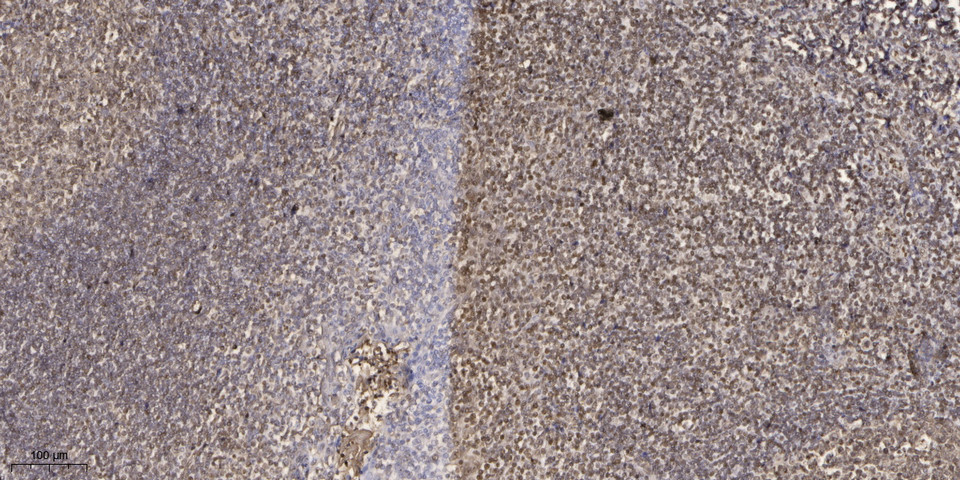Menin Polyclonal Antibody
- Catalog No.:YT2732
- Applications:WB;IHC;IF;ELISA
- Reactivity:Human;Mouse;Rat
- Target:
- Menin
- Fields:
- >>Cushing syndrome;>>Transcriptional misregulation in cancer
- Gene Name:
- MEN1
- Protein Name:
- Menin
- Human Gene Id:
- 4221
- Human Swiss Prot No:
- O00255
- Mouse Gene Id:
- 17283
- Mouse Swiss Prot No:
- O88559
- Rat Gene Id:
- 29417
- Rat Swiss Prot No:
- Q9WVR8
- Immunogen:
- The antiserum was produced against synthesized peptide derived from human MEN1. AA range:181-230
- Specificity:
- Menin Polyclonal Antibody detects endogenous levels of Menin protein.
- Formulation:
- Liquid in PBS containing 50% glycerol, 0.5% BSA and 0.02% sodium azide.
- Source:
- Polyclonal, Rabbit,IgG
- Dilution:
- WB 1:500 - 1:2000. IHC 1:100 - 1:300. ELISA: 1:20000.. IF 1:50-200
- Purification:
- The antibody was affinity-purified from rabbit antiserum by affinity-chromatography using epitope-specific immunogen.
- Concentration:
- 1 mg/ml
- Storage Stability:
- -15°C to -25°C/1 year(Do not lower than -25°C)
- Other Name:
- MEN1;SCG2;Menin
- Observed Band(KD):
- 67kD
- Background:
- This gene encodes menin, a putative tumor suppressor associated with a syndrome known as multiple endocrine neoplasia type 1. In vitro studies have shown menin is localized to the nucleus, possesses two functional nuclear localization signals, and inhibits transcriptional activation by JunD, however, the function of this protein is not known. Two messages have been detected on northern blots but the larger message has not been characterized. Alternative splicing results in multiple transcript variants. [provided by RefSeq, Oct 2008],
- Function:
- disease:Defects in MEN1 are the cause of familial isolated hyperparathyroidism (FIHP) [MIM:145000]; also known as hyperparathyroidism type 1 (HRPT1). FIHP is an autosomal dominant disorder characterized by hypercalcemia, elevated parathyroid hormone (PTH) levels, and uniglandular or multiglandular parathyroid tumors.,disease:Defects in MEN1 are the cause of familial multiple endocrine neoplasia type I (MEN1) [MIM:131100]; an autosomal dominant disorder characterized by tumors of the parathyroid glands, gastro-intestinal endocrine tissue, the anterior pituitary and other tissues. Cutaneous lesions and nervous-tissue tumors can exist. Prognosis in MEN1 patients is related to hormonal hypersecretion by tumors, such as hypergastrinemia causing severe peptic ulcer disease (Zollinger-Ellison syndrome, ZES), primary hyperparathyroidism, and acute forms of hyperinsulinemia.,function:May be invol
- Subcellular Location:
- Nucleus . Concentrated in nuclear body-like structures. Relocates to the nuclear matrix upon gamma irradiation.
- Expression:
- Ubiquitous.
- June 19-2018
- WESTERN IMMUNOBLOTTING PROTOCOL
- June 19-2018
- IMMUNOHISTOCHEMISTRY-PARAFFIN PROTOCOL
- June 19-2018
- IMMUNOFLUORESCENCE PROTOCOL
- September 08-2020
- FLOW-CYTOMEYRT-PROTOCOL
- May 20-2022
- Cell-Based ELISA│解您多样本WB检测之困扰
- July 13-2018
- CELL-BASED-ELISA-PROTOCOL-FOR-ACETYL-PROTEIN
- July 13-2018
- CELL-BASED-ELISA-PROTOCOL-FOR-PHOSPHO-PROTEIN
- July 13-2018
- Antibody-FAQs
- Products Images
.jpg)
- Western Blot analysis of HuvEc cells using Menin Polyclonal Antibody diluted at 1:500

- Immunohistochemical analysis of paraffin-embedded human tonsil. 1, Antibody was diluted at 1:200(4° overnight). 2, Tris-EDTA,pH9.0 was used for antigen retrieval. 3,Secondary antibody was diluted at 1:200(room temperature, 45min).



